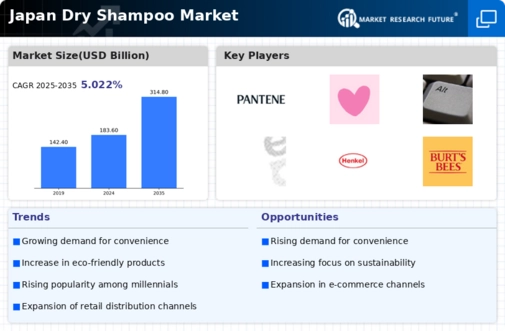Increased Awareness of Hair Health
There is a growing awareness among Japanese consumers regarding hair health, which is positively influencing the dry shampoo market. As individuals become more informed about the effects of frequent washing and the benefits of using dry shampoo, they are more inclined to incorporate these products into their hair care routines. The dry shampoo market is benefiting from this trend, as consumers seek alternatives that minimize damage to their hair while providing convenience. Market Research Future suggests that approximately 30% of consumers now prefer dry shampoo over traditional washing methods, indicating a significant shift in consumer behavior. This heightened awareness of hair health is likely to continue driving growth in the industry.
Innovations in Product Formulation
Innovations in product formulation are playing a crucial role in the evolution of the dry shampoo market. Manufacturers are increasingly focusing on developing advanced formulas that cater to diverse hair types and preferences. This includes the introduction of natural ingredients and formulations that are free from harmful chemicals, appealing to health-conscious consumers. The dry shampoo market is witnessing a rise in products that not only absorb oil but also nourish and protect hair. Market data indicates that products with natural ingredients have seen a 40% increase in sales, reflecting a shift towards cleaner beauty products. Such innovations are likely to attract a wider consumer base, thereby enhancing the growth potential of the industry.
Rising Urbanization and Lifestyle Changes
The increasing urbanization in Japan is driving the demand for the dry shampoo market. As more individuals move to urban areas, their lifestyles become busier, leading to a greater need for convenient grooming solutions. The fast-paced nature of city life often leaves little time for traditional hair washing routines. Consequently, dry shampoo emerges as a practical alternative, allowing consumers to maintain their hair hygiene without the need for water. This shift in lifestyle preferences is reflected in market data, which indicates that the dry shampoo market has experienced a growth rate of approximately 15% annually in urban regions. The convenience offered by dry shampoo products aligns with the needs of urban dwellers. This alignment is propelling the industry forward.
Expansion of Retail Channels and E-commerce
The expansion of retail channels and e-commerce platforms is facilitating access to dry shampoo products in Japan. With the rise of online shopping, consumers can easily explore a wide range of dry shampoo options from the comfort of their homes. This trend is particularly relevant in a country where convenience is highly valued. The dry shampoo market is experiencing a notable increase in sales through e-commerce, with reports indicating a growth of 25% in online sales over the past year. Additionally, brick-and-mortar stores are also expanding their offerings, making dry shampoo more accessible to a broader audience. This dual-channel approach is likely to enhance the visibility and availability of dry shampoo products, further propelling the industry.
Influence of Social Media and Beauty Trends
The impact of social media on beauty trends is profoundly shaping the dry shampoo market in Japan. Influencers and beauty enthusiasts frequently promote dry shampoo as a must-have product for achieving effortless hairstyles. This trend is particularly appealing to younger demographics, who are increasingly influenced by online content. As a result, the dry shampoo market is witnessing a surge in demand, with sales reportedly increasing by 20% among consumers aged 18 to 34. The visibility of dry shampoo in beauty tutorials and lifestyle blogs contributes to its growing popularity, making it a staple in the beauty routines of many Japanese consumers. The industry's ability to adapt to these trends is crucial for its sustained growth.





















Leave a Comment